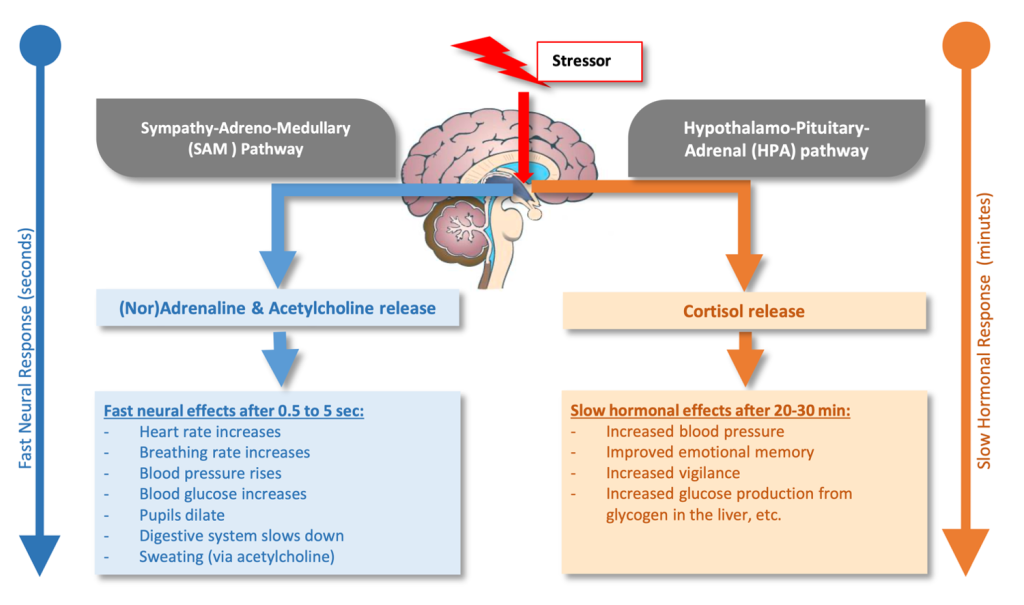EmoGraphy provides insight in how we respond to stress. Humans respond to stress in two ways: an immediate response to the stressor (adrenaline release) and a slower response (cortisol release) to recover from that stressor. Stress has a direct impact on our cognitive performance. High cortisol levels may negatively affect cognitive performance such as contemplation, strategic thinking and memory function. Low levels are thought to increase fatigue by making tasks appear tougher, and limiting endurance of sustained physical and mental activities.
EmoGraphy provides detailed insights in this mechanism by displaying stress levels in real-time and calculating the related cognitive functioning of the brain – the CognitiveZone – that is impacted by cortisol. Through these measurements and calculations, EDA can also predict changes in cognitive abilities up to an hour ahead (assuming the user performs similar activities).
EmoGraphy is based on skin conductance (EDA); an accurate measurement of sympathetic nervous system activity that reflects the body’s so-called fight or flight response. The Cognitive Zones help the user to understand how to optimize his/her cognitive performances and avoid under- and over-stimulation.
CardioWatch metrics specifications
The sampling rate of the raw BioZ signal is 25Hz.
Stress Level Skin Conductance
| Acquisition time | 1 minute |
| Update interval | 1 minute (*) |
| Range | 0 to 1000 |
| Sampling rate | once per second |
(*) The one-minute output is derived from the processing of one-second data
Cognitive Zone
| Acquisition time | Data are coming after ~30-minute monitoring period The algorithm is adaptive, so accuracy improve with time. |
| Update interval | 1 minute |
| Range | Four values (see definitions below): Undefined, Under Stimulated, Balanced, Over Stimulated |
| Sampling rate | once per minute |
Detailed descriptions
Stress Level
Stress Level reflects the immediate response to a stressor. It indicates the amount of physical (strong exercise, spicy food, or the temperature) and emotional stress of the user at present time.
Cognitive Zone
Cognitive Zone is based on the slower response (cortisol release) to a stressor. By remaining in a zone of optimal emotional stimulation, you can avoid both drowsiness and too much stress. This is the objective of Cognitive Zone. The Balanced Zone represents the area of emotional fitness, essential for healthy lifestyle and optimal cognitive performance.
Metric output
Cognitive Zone is the current cognitive zone at present time
Cognitive Zone in One Hour is a prediction of the cognitive zone in one hour assuming the user performs similar activities as at present time
Predictive Cognitive Zone is the next predicated cognitive zone in a number of minutes given by the Predictive Cognitive Zone Transition Time.
Predictive Cognitive Zone Transition Time is the time to reach the next predicted cognitive zone
Cognitive Zones
Over stimulated zone
Decreased cognitive performance; strategic thinking, memory, etc. – you might want to do a relaxing exercise to reach the balanced zone for optimal performance
Balanced zone
Optimal cognitive performance – to stay in this zone take regular breaks
Under stimulated zone
Enhanced perception of effort, reduced endurance of mental activity – you might want to take a walk or activity to stimulate yourself to reach the balanced zone
Cortisol Contribution
The Cognitive Zones are derived from the estimated Cortisol Contribution which is the amount of cortisol that can be accounted for by stress. Cortisol is the most accurate measure of stress but it can only be measured via blood, hair or saliva samples. By calculating the cortisol contributions, the EDA algorithm is able to determine the easy-to-understand CognitiveZone.
Scientific Background
Selye, 1936 defined stress as “…the non-specific response of the body to any demand for change” caused by a single or accumulation of events over time. The body & brain do not distinguish different types or valence of stress. The following diagram shows the body’s biological response to a stressor:

SAM: The Sympathetic nervous system stimulates “fight-or-flight” response to stressors, inhibiting “rest- and-digest” functions. Acetylcholine is released, mediated by adrenalin and noradrenalin.
HPA: Cortisol is released by the adrenal cortex to help the body deal with stressors. Increases blood pressure and blood glucose levels for immediate energy distribution to muscles and brains at the expense of processes not needed for immediate survival.
Sweat glands are direct coupled to stress clean indicator of sympathetic activity
• Sympathetic nervous system stimulates fight-or- flight response to stressors
• Sweat glands are the only organs singularly coupled to the sympathetic nervous system providing a cleaner measure of stress
• Other organs (e.g. heart) are coupled to both the sympathetic and parasympathetic nervous system
• Cortisol and skin conductance responses are both direct results of the same stressor and are thus related
